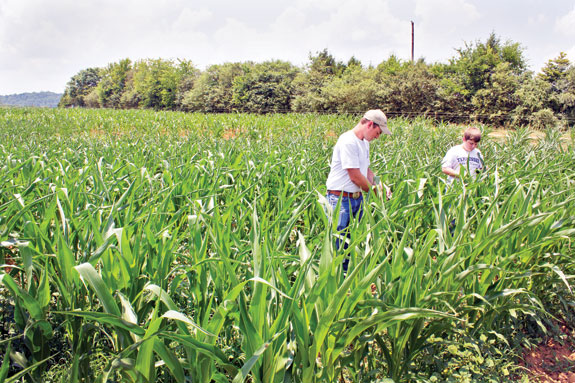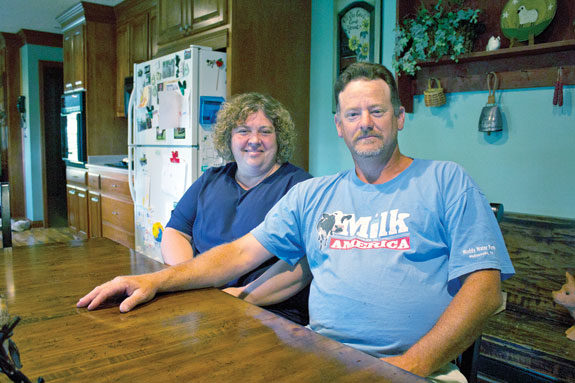Lay, owner of Muddy Water Farm in Madisonville, Tennessee, was referring to his decision to switch from conventional farming to organic farming a little over two years ago.
The Lay family is in the third and final year of the organic transitioning period.
“The crop rotations are the biggest,” Lay continued. “And then the timing of the seeding. When you conventional farm – when you want to reseed – you just kill it and plant it. In the organic system, you’ve got to work with nature. Instead of forcing your way in, you’re working with it.”
Lay started milking on his father’s dairy when he was in high school. He went to college for two years but came home every weekend to help with the milking.
In 1994, he and his wife, Lisa, purchased the cows and leased the dairy facilities and land from his father. That is where they’re at today.
“It’s so hard to get into farming,” Lay said. “If you go in on rented land and then own all of your cows, that’s the way to do it.”
The downturn in 2009 was the catalyst for Lay to start taking a hard look at organic farming.
“Organic Valley (a co-op with headquarters in La Farge, Wisconsin) put in a quota system to their producers,” Lay said. “They told every one of their members to drop their production by 7 percent across the board.
Organic Valley was able to hold their prices. You talk about that in the conventional world and the farmers want a government payment to make up the difference.
Well, no, we’re all in this together. So that’s what really impressed me about Organic Valley. They showed leadership.
“When things turned around in 2010, they lifted that restriction and they’ve been growing at 12 to 15 percent ever since.”
When it comes to organic farming, weather plays an even bigger role than normal. The University of Nebraska – Lincoln maintains a United States Drought Monitor. According to their website, much of Tennessee is suffering a “moderate to severe” drought.

The Lays had to plant their organic corn on May 18 this year, about three weeks later than they wanted due to the lack of rain.
Lay said, “All of our hay was put up as small, square bales this year, just from the fact that the hay was shorter.
We will purchase some round bales for the heifers at a later date, probably from a source in Ohio to cut down on the freight.”
Another challenge for organic farmers is simply trying to find the seed that meets their criteria.
The Lays have been purchasing from the Koeshells out of Philadelphia, Tennessee, located about 10 miles away from the Lay farm.
“Organic is a challenge just because of the amount of people that are doing it,” said Sam Koeshell. “Another thing that is different about organic seed is that there is a lot of paperwork and getting it registered – making sure you can grow it as organic.
There is a limited amount of supply as far as getting organic corn and different organic forage summer and winter annuals.”
The balancing act for organic farmers hinges on crop rotation. It’s something the Lays are still experimenting with.
“A lot of attention is put on the summer annuals but our perennial grasses, our base – your fescues, your orchardgrasses, your clover … I think they get left out,” Lay said. “And they are so important to get you through.
“Organically, you just can’t kill that one day and plant it the same day. You’ve either got to work the land under or mechanically kill that land and then you wait for another rain to come.
When your rains are coming three weeks apart, you’ve lost three weeks. I don’t have a summer annual sown simply because we haven’t had the weather to sow it. We’re learning that you can’t rely on summer annuals. They’re good but they’ll bite you.”
The Lays’ basic rotation is sowing grasses in the fall, with some forage oats or ryegrass mixed in to increase tonnage. On any cropland they are rotating, they’ll go to a clover or a clover-and-ryegrass mix. They take that off in the spring, plow it down and then plant corn.
Lay explained, “Usually I have one field that I haul manure on in the winter and then in the spring we’ll work that field down and sow in some oats and peas and then, normally, we can take those peas off in late May.
If you get them straight off, if the weather cooperates, you can go back and no-till a sorghum-sudan into it. Your sorghum-sudan will take root and smother any weeds out. Then we come back and put that field down in a permanent grass.
On your corn land, you’ll chop that down and turn that field into a permanent grass. Then you can do a two-year rotation on the corn.”
Lay said that he’s seeing about a 50 percent yield compared to when he was farming conventionally. He claims that is strictly a management issue and that other organic farmers he has spoken to are seeing yields that are equal to conventional.
Despite the challenges, the Lays remain optimistic about the future of their farm.
“Different years call for different things,” Lay said. “It’s getting to know your soils and what crops grow in your soils. You’re experimenting a little bit and I think that’s what makes farming fun.” FG
PHOTOS
TOP: Lisa and Butch Lay own Muddy Water Farm in Tennessee.
BOTTOM: Their sons Jacob and Aaron, are in their third and final year of transitioning over to organic farming and are still learning about crop rotations and what works the best for their farm. Photos courtesy of Fredric Ridenour.










